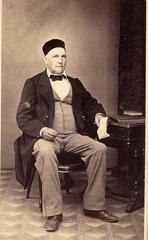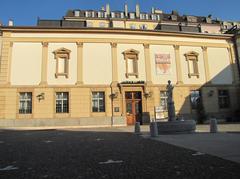Haut-Vully Visiting Hours, Tickets & Historical Sites Guide
Date: 15/06/2025
Introduction to Haut-Vully: Where History and Nature Meet
Nestled between Lake Morat (Murtensee) and Lake Neuchâtel in Switzerland’s picturesque Three-Lakes Region, Haut-Vully is a destination that blends rich, multi-layered history with breathtaking landscapes and vibrant cultural traditions. Prehistoric pile dwellings, Celtic oppida atop Mont Vully, Roman relics, and medieval villages chart a journey through thousands of years of human habitation and evolution. The area developed as a vital hub for trade, agriculture, and defense—evident in its enduring Roman and medieval structures. Today, Haut-Vully is equally famed for its scenic hiking trails, flourishing vineyards, and unique wartime grottos from World War I, offering visitors a diverse array of experiences.
Accessible throughout the year, Haut-Vully’s historical sites and outdoor attractions ensure there is something for every traveler—whether you are a history enthusiast, wine lover, or nature seeker. This guide covers everything you need: site opening hours, ticket information, access and transport tips, guided tours, cultural events, and practical advice for planning your visit. For up-to-date visitor details and resources, consult the Mont Vully tourism website.
Contents
- Early Settlement and Prehistoric Heritage
- Roman and Medieval Developments
- Religious and Educational Transformations
- Modernization, Water Management, and Agricultural Evolution
- 20th-Century Heritage and Wartime Remnants
- Administrative Changes and Contemporary Identity
- Planning Your Visit: Hours, Tickets, and Access
- Winegrowing and Gastronomy
- Family-Friendly & Outdoor Activities
- Frequently Asked Questions (FAQ)
- Summary and Visitor Recommendations
- Sources and Further Reading
Early Settlement and Prehistoric Heritage
Haut-Vully’s lakeside location made it a cradle of civilization from the Neolithic era. Archaeological finds reveal prehistoric pile dwellings and lakeshore settlements, including the UNESCO-listed Môtier I site, which yielded a 70cm-thick layer of artifacts and evidence of a thriving lakeshore community (myswitzerland.com; hls-dhs-dss.ch; Wikipedia - Haut-Vully). The area’s abundant resources and strategic waterways supported a network of prehistoric cultures.
During the Iron Age, the Celtic Helvetians built a large oppidum (fortified settlement) atop Mont Vully. Remnants of ramparts and earthworks are still visible, and the site is considered a key Celtic fortification in Switzerland, underscoring Haut-Vully’s historic role as a crossroads of trade and culture (myswitzerland.com; destination-montagne.ch).
Roman and Medieval Developments
The Romans left their mark through infrastructure, notably wooden bridges and roads uncovered in the Grand Marais marshes near Môtier during 20th-century water correction projects (ostia-antica.org). These finds show Haut-Vully’s integration into the Roman transport and trade network.
In the Middle Ages, villages like Môtier, Lugnorre, Joressant, and Mur flourished as agricultural and viticultural communities. The earliest written record dates to 968/985 as “Vuisliacense,” with the region’s identity shaped by its fertile land and proximity to waterways (hls-dhs-dss.ch; Wikipedia - Haut-Vully).
Religious and Educational Transformations
The Protestant Reformation had a profound impact, with the parish of Môtier playing a central role in the new faith. The establishment of schools from 1561 onward highlights Haut-Vully’s early commitment to education and literacy (hls-dhs-dss.ch). This educational tradition endures, reflecting broader societal shifts.
Modernization, Water Management, and Agricultural Evolution
Large-scale engineering works in the 19th and 20th centuries, notably the Jura water corrections, drained marshes and expanded farmland, reshaping the landscape for intensive agriculture (ostia-antica.org). Land consolidation between 1962 and 1992 modernized farming further, preserving vineyards and boosting the local wine industry (hls-dhs-dss.ch). Today, about 150 hectares of vines cover Mont Vully’s southern slopes, producing celebrated wines (myswitzerland.com; fribourg.ch).
20th-Century Heritage and Wartime Remnants
Haut-Vully’s strategic role continued into the 20th century. During World War I, the Swiss military built fortifications above Môtier, including the “grottes de la Lamberta”—cave-like shelters now open to visitors (myswitzerland.com). Local legends, such as rotating “abrasive blocks” and tales of witches’ dances, add a mystical dimension (destination-montagne.ch).
Administrative Changes and Contemporary Identity
In 2016, Haut-Vully merged with Bas-Vully to form the commune of Mont-Vully, uniting key villages and streamlining governance (hls-dhs-dss.ch). Despite modernization, the area retains its rural character, with tourism, viticulture, and culinary traditions at its heart.
Planning Your Visit: Hours, Tickets, and Access
Main Historical Sites & Opening Hours
- Mont Vully Oppidum & Outdoor Sites: Open year-round, free access.
- Grottes des Roches Grises (WWI Grottos): Open April–October, daily 9:00–18:00; CHF 5 for adults, discounts for children/seniors.
- Sentier historique du Vully Trail: 7.5 km, open year-round, 24/7 (Sentier historique du Vully).
- Tour des Sarrasins: Accessible during daylight; check local info for seasonal access.
- Réduit du Vully (Military Fortifications): Open April–October, 9:00–18:00; CHF 5 for adults.
Tickets & Guided Tours
- Outdoor sites are generally free; some exhibitions and guided tours require advance booking and tickets (CHF 15–25/person).
- Book guided tours via Vully Tourisme or at the local tourism office.
Getting There & Accessibility
- By Train: Nearest station is Sugiez, with connections from Murten and Neuchâtel.
- By Car: Parking available in villages.
- By Boat: Lake Murten cruises connect Haut-Vully with other lakeside towns (Lake Murten Cruises).
- Public Transport: Buses link villages and attractions; Neuchâtel Tourist Card offers free public transport for overnight guests.
- Accessibility: Lakeshore and village centers are wheelchair accessible; trails may have uneven terrain.
Winegrowing and Gastronomy
The sun-drenched southern slopes of Mont Vully are home to about 150–152 hectares of vineyards, representing 1% of Switzerland’s viticultural area (MySwitzerland - Vully; Fribourg.ch - Vully). Over 26 grape varieties are cultivated, including Chasselas (“Vully”), Pinot Noir, Traminer, and Pinot Gris. Family-run wineries offer cellar tours and tastings, especially during the Vully Wine Festival each September—a highlight for visitors (MySwitzerland - Vully).
Local Specialties
Enjoy Vully Tart (Gâteau du Vully) in both sweet and savory varieties, best paired with local wines. Restaurants emphasize fresh lake fish, regional produce, and blend French, Swiss, and German culinary traditions.
Family-Friendly & Outdoor Activities
- Hiking: The 7.5 km Sentier historique du Vully is suitable for families, with interpretive panels, picnic spots, and panoramic viewpoints (Swiss Mobility).
- Cycling: Marked bike routes traverse the vineyards and lakeshore (happytowander.com).
- Swimming & Water Sports: Lake Murten offers swimming, kayaking, paddleboarding, and boat cruises.
- Picnicking: Numerous scenic spots along the trail and lakeshore.
- Playgrounds & Events: Family-friendly events, treasure hunts, and workshops are common during festival seasons.
Frequently Asked Questions (FAQ)
Q: Are most sites free to visit?
A: Yes, outdoor sites and trails are free. Some guided tours and exhibitions have a small fee.
Q: What are typical opening hours?
A: Outdoor sites are open year-round. Grottos and military sites: April–October, 9:00–18:00.
Q: How do I book guided tours?
A: Contact Vully Tourisme or local visitor centers.
Q: Is the region accessible for mobility-restricted visitors?
A: Village centers and lakeshore paths are accessible; trails and grottos may be challenging.
Q: When is the best time to visit?
A: Late spring to early autumn for mild weather, wine festivals, and outdoor activities.
Summary & Visitor Recommendations
Haut-Vully offers a seamless blend of ancient heritage, vibrant community life, and natural beauty. Whether you explore prehistoric settlements, walk the Sentier historique du Vully, tour vineyards, or relax by Lake Murten, you will experience the enduring relationship between people and their landscape. The region’s accessible infrastructure, diverse attractions, and welcoming atmosphere make it ideal for families, history buffs, and outdoor enthusiasts.
For current information on opening hours, tickets, and events, visit the Vully Tourism Office and enhance your experience with tools like the Audiala app.
Sources and Further Reading
- Mont Vully tourism website (myswitzerland.com)
- Wikipedia - Haut-Vully
- Vully Tourism Office (levully.ch)
- Sentier historique du Vully (myswitzerland.com)
- Region Murtensee/Lac de Morat
- Loisirs.ch - Sentier historique du Vully
- Ostia-Antica.org - Haut-Vully
- Swiss Historical Dictionary (hls-dhs-dss.ch)
- Lake Murten Cruises
- Happy to Wander - Switzerland Travel Tips

